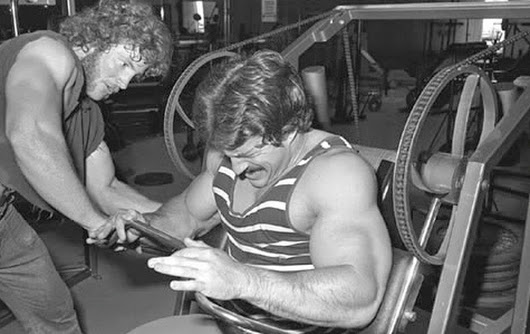Misconceptions and wrong ideas abound in weight training, probably because so many enthusiastic amateurs are involved in it. In this article, I’ll try to clear up some of the misconceptions with a look at at science-based weight training.
In recent articles, we saw that brief workouts, at 15 minutes, done infrequently, at twice a week, can produce significant strength gains. We saw that compound lifts, not isolation lifts, are the most effective strength exercises, and are essential for the serious strength trainer. And we saw that hard weight lifting causes muscle damage, which necessitates recovery time.
Here I’ll focus on what science has to say about additional aspects of weight lifting (resistance training). These come from “Evidence-Based Resistance Training Recommendations” by Fisher et al.1 (Full paper.)
Intensity of Effort
When you lift weights, muscle fibers are “recruited”, which means that as repetitions continue and become more difficult, the body demands that more muscle fibers come into play and perform work. At the final repetition, the point of failure, all muscle fibers possible are recruited, and this is the most important step in muscle growth (hypertrophy).
Recommendation: Train to momentary muscular failure in order to recruit all possible muscle fibers. Do not train to a set number of repetitions. (For more on this, see my article on high-intensity training.)
Load and Repetition Range
If a set of repetitions is performed to failure, it makes little to no difference how much weight (load) you use. This comes with the caveat that there are limits to this. For instance, if you choose a weight with which you can do 30 reps, or 1 rep, these are unlikely to optimally recruit muscle fibers. But otherwise, studies have found little difference on muscle hypertrophy in lifting heavy weights (90% of max possible, or 90%RM), or lighter weights (30%RM), so long as the lift is done to failure. However, heavier weights (80%RM) appear to increase bone mineral density more than lighter.
Recommendation: Select a weight of 80%RM and do reps to failure, which is optimal for strength, muscular endurance, and bone density.
Repetition Duration
Repetition duration refers to cadence, that is, the amount of time it takes to perform 1 rep, i.e. slow vs fast. Repetitions should be done at a slow enough pace that muscular tension is always maintained. Fast reps or using momentum — jerking the weights around — do not maintain muscular tension.
Recommendation: Lift slowly enough to maintain muscular tension. In extreme cases, this may be 10 seconds up, 10 down, though that doesn’t appear to be necessary. I use a cadence of 4-5 seconds up, same down.
Rest Intervals
This is the time spent between sets, and the preponderance of scientific evidence shows that it has little effect on strength gains.
For pure muscle growth, don’t worry about rest intervals. Take as much or as little time as you like.
However, rest intervals may make a difference to cardiovascular conditioning. If you want to emphasize the cardiovascular aspect of training, short rest intervals are better.
Recommendation: Select your own rest interval for muscle growth. Use short rest intervals for cardiovascular conditioning.
Volume and Frequency
These refer to the number of sets and the frequency of training sessions, and this area shows probably the greatest disparity between what most people, including veteran lifters, believe, and what the science says.
There’s little evidence that performing more than 1 set of each exercise increases muscle growth, if that 1 set is done to failure.
There’s little evidence to support any recommendation as to frequency. Some studies have reported no difference with a training frequency of once vs twice a week, other studies showing no difference between twice or three times a week. My own experience tells me that you can train so long as you feel fully rested and recovered.
Recommendation: Single set training appears to be as effective as multiple sets for muscle growth. There’s little scientific evidence for a recommendation as to frequency of training.
Endurance Training and Lifting
Some people worry that doing endurance training might hinder their lifting gains. There’s no evidence that it does, so do endurance training also if that’s what you want to do. However, additional training may hinder recovery time.
Recommendation: Endurance training doesn’t hinder muscle growth.
Range of Motion
Most trainers recommend you use a full range of motion for each rep in order to get the most growth. But there’s no evidence for this. A restricted range of motion appears to increase strength and size as much as full range.
Recommendation: Use any range of motion you like.
Machines vs Free Weights
Another controversial area. Evidence directly comparing the two is meager, but machines do increase size and strength. A muscle doesn’t know whether you’re using a machine or a barbell.
Machines may make it easier to perform a lift to failure. For instance, trying to go to failure on a set of squats is asking for trouble, namely injury. Not a problem to do so on a leg press or hack squat machine.
Just about the only barbell exercise that I’m aware of that has no machine equivalent is the deadlift.
Recommendation: Use either machines or free weights as you wish.
Training and Detraining
A mere 3 weeks of training is enough to produce muscle growth in untrained people.
Of more interest, how long does it take, when no training is done, to lose muscle strength?
Again, 3 weeks of no training appears to have little to no effect on muscle strength. Most dedicated lifters don’t ever take that much time off, but this shows that allowing adequate rest between training sessions, even of considerable length, will not hurt gains.
Recommendation: If you feel the need to take some time off, or just can’t manage to get to the gym for awhile, don’t worry about it.
Conclusion
Many of these recommendations are to a greater or lesser extent at odds with common training methods, the kind that you hear from a trainer or gym bro.
It’s entirely possible that scientific studies miss some important aspects of training that come from years of bodybuilding experience. Resistance training studies normally last only about 12 weeks, and most have been done using untrained people.
But, when science looks at techniques, muscle protein synthesis, frequency of training, and the like, these are the conclusions, and they form our base of knowledge as it relates to weight training.
If I had to pick a single one of the above recommendations to emphasize, it would be intensity of effort, which appears to be the single most important aspect in attaining growth in strength and size.
PS: For much more on the health benefits of strength training as well as how to begin a training program, see my book Muscle Up.

PPS: Check out my Supplements Buying Guide for Men.
- Fisher, James, et al. “Evidence-based resistance training recommendations.” Med Sport 15.3 (2011): 147-162. ↩














32 Comments
Strength training recommendations really have done a great disservice to people in the past. many people don’t even attempt it because the don’t have the time or will to be in the gym 1h four days a week. the reality is that the difference between no strength training and training once a week are enormous, and everything past that isn’t that important. public health would be so much better if everyone lifts some weights at least once a week, especially if this effort is sustained for years.
I couldn’t agree more.
That’s a great article! I did a video beast workout for 9 weeks over the summer when I had time with awesome results. Now that I’m teaching and coaching again, I’ve been too busy to go 6 days a week for 30-60 minutes, and my enthusiasm has dropped. Couple that with the intense PT I’m doing for my knee, and I was thinking all that work over the summer was going to be for nothing in a matter of weeks. I can’t wait to start on this! TYVM, Hans to my Franz!
I’m referring to your HiT workout, btw
Thanks, Sean!
Excellent summary!
Well done!
A great service!
Thanks, Jerome!
Been in a routine of 3 x 30 minute workouts per week, around 80% 1RM, slow cadence, for some years now, and the results have been great. People don’t believe me when I tell them how long I spend in the gym per week.
For me, there’s no competition between machines and compound movements on freeweights – you’re simply using a lot more muscles at once in the case of the latter and can improve the efficiency of your workouts, arguments about range of motion and “functional” notwithstanding.
Simon, I guess the issue for me is that while I love free weights, there are certain exercises that are just plain dangerous to do to failure. Overhead dumbbell press, bent over rows, deadlifts and the like are easier to bail out if you need to, but bench and squat don’t have that luxury. I hate hate hate smith machines, but it seems like switching over to a smith for bench and leg press for squat might be beneficial based on this information. Maybe mixing in fly-type dumbbell reps would help in terms of range of motion and weight control that you lose with a smith vs normal bench, or maybe just do dumbbell bench instead, even if it’s a bit of a pain?
Lou, you can always do bench in the power rack with the safety bars set, to do barbell bench solo safely.
Failing that, you can find a bench with good face-savers/safety bars as well.
Lou, Squats absolutely do have a failsafe. There are safety bars in a powercage over which the athlete is supposed to perform the exercise, if necessary the athlete can drop the barbell, it will land on the safety bars and the athlete can safely get out from underneath it.
This concept works the same with the bench press.
If one does not eat much junk, moderate weight training is enough to maintain a decently lean body and keep the fat off. I’ve been experimenting with lighter weights with more reps so I can avoid tendinitis in my elbows. I’m not interested in getting big but like to be able to do stuff without too much physical suffering later.
Excellent, thanks for this.
Mike Mentzer proven correct!
FORGET THE B.S. ISOLATION EXERCISES!!
Don’t go too slow in the cadence. 2-3 sec DOWN, I.e. the lowering of the weight, is the key part
I’ve heard a lot that training to failure has an adverse effect on the nervous system. I have felt this way in odd times where I felt that I had “overtrained.”
Do you have any science-based information about how diet affects this sort of thing? I’ve been needing to “cut” for several months now, but I’ve also heard that one can simply “reconstitute” by eating maintenance calories and continuing your fitness routine. But it is also said to be difficult to make strength gains when eating at or below maintenance calories.
Hm, I think solid meta-analyses of hundreds of weight lifting studies contradict a lot of this. See the large reviews by Matthew R. Rhea.
Peterson, M. D., Rhea, M. R., & Alvar, B. A. (2004). Maximizing strength development in athletes: a meta-analysis to determine the dose-response relationship. The Journal of Strength & Conditioning Research, 18(2), 377-382.
Rhea, M. R. (2004). Synthesizing strength and conditioning research: the meta-analysis. The Journal of Strength & Conditioning Research, 18(4), 921-923.
“There’s little evidence that performing more than 1 set of each exercise increases muscle growth, if that 1 set is done to failure.”
Studies of untrained and trained weight lifters show increasing strength/muscle gains up to 4 sets, and for trained athletes higher strength/muscle gains up to 8 sets!
“These findings, which were determined by using data from nearly 200 studies, identified a dose-response relationship for the continuum of training intensities, frequencies, and volumes, and resultant strength increases … Specifically, ES data demonstrated that, for untrained individuals, maximal strength gains are elicited at a mean training intensity of 60% of 1 repetition maximum (1RM), 3 days per week, and with a mean training volume of 4 sets per muscle group. Recreationally trained nonathletes exhibit maximal strength gains with a mean training intensity of 80% of 1RM, 2 days per week, and a mean volume of 4 sets. For athlete populations, maximal strength gains are elicited at a mean training intensity of 85% of 1RM, 2 days per week, and with a mean training volume of 8 sets per muscle group.”
And lifting to failure is shown to not even matter:
“As can be seen in the Figure 7, training-to-failure does not elicit greater gains than not training-to-failure. This is true even when multiple sets of training-to-failure are compared with training sessions that are not training-to-failure.”
https://journals.lww.com/nsca-jscr/Abstract/2005/11000/Applications_of_the_Dose_Response_for_Muscular.38.aspx
Peterson, M. D., Rhea, M. R., & Alvar, B. A. (2004). Maximizing strength development in athletes: a meta-analysis to determine the dose-response relationship. The Journal of Strength & Conditioning Research, 18(2), 377-382.
Rhea, M. R. (2004). Synthesizing strength and conditioning research: the meta-analysis. The Journal of Strength & Conditioning Research, 18(4), 921-923.
Rhea, M. R. (2004). Synthesizing strength and conditioning research: the meta-analysis. The Journal of Strength & Conditioning Research, 18(4), 921-923.
Here’s another newer meta-analysis, btw. Check out figures 2 and 4. More sets = more muscle & strength gains. The highest category – 4 to 6 sets – shows the highest effect sizes. 1 Set is definitely not as effective as multiple sets.
Krieger, J. W. (2010). Single vs. multiple sets of resistance exercise for muscle hypertrophy: a meta-analysis. The Journal of Strength & Conditioning Research, 24(4), 1150-1159.
https://journals.lww.com/nsca-jscr/Abstract/2010/04000/Single_vs__Multiple_Sets_of_Resistance_Exercise.36.aspx
Ah, I see now that Dr. Mangan is summarizing a review paper by James Fisher, and Fisher is skeptical of meta-analyses. He faults the Krieger paper for not separating the studies by trained and untrained athletes, apparently unaware that the Rhea & Peterson meta-analyses do this and find the same thing.
There is no attempt by Fisher to examine the data for biased variables, he just suggests they might be there and assumes that is a good argument against the quantitative review. Weak.
Sorry, Dr. M, this is my last post for this! I think Fisher’s rejection of strength training meta-analyses makes this advice wrong. The best evidence comes from pooling large numbers of studies.
“This is the time spent between sets, and the preponderance of scientific evidence shows that it has little effect on strength gains”
But here’s a meta-analysis on this very question, and 3-5 minute rest times are associated with greater strength gains than shorter rest intervals:
“… 3–5 minutes’ rest between sets allowed for greater repetitions over multiple sets. Furthermore, in terms of chronic adaptations, resting 3–5 minutes between sets produced greater increases in absolute strength, due to higher intensities and volumes of training. Similarly, higher levels of muscular power were demonstrated over multiple sets with 3 or 5 minutes versus 1 minute of rest between sets.”
https://link.springer.com/article/10.2165/11315230-000000000-00000
I am currently using Jim Wendler’s 531 programme and like it a lot. My strength is improving consistently but I have struggled to settle on accessory work. Should I use a bro split, should I do an upper/lower, should I do a combination of both? After reading this article I get the idea that as long as you go completely balls-out on your workout, none of the other crap is really significant. Hit the big lifts hard, compliment it with some other stuff, allow enough time to properly recover and you will get results.
Benjamin, I think the last sentence of your comment is exactly right. Other stuff might result in some improvement, but likely marginal compared to the effort.
“A mere 3 weeks of training is enough to produce muscle growth in untrained people.”
That worries me a lot. I’ve been lifting for about 1 year and have seen no substantial difference in muscle mass (gained aprox. 1kg of lean muscle in this period). I have absolutely no idea of what I’m doing wrong, and it leads to demotivation. It usually goes like this:
1) Start lifting
2) 2-3 months in, see no results
3) Demotivate, stop for 1-2 weeks
4) Rinse and repeat
I have seen a difference in strength, though. I used to not be able to do a single pull-up, now I can do a set of them. But no noticeable muscle mass gain.
Any help appreciated.
I am by no means any kind of an expert but have read extensively on the subject since becoming seriously interested in strength training.
I dossed about doing the typical stuff for 12 months before running the app Stronglifts in January of this year. Since running that programme and now having switched to 531 my squat has gone from a very iffy 100kg for a couple to a nice deep 155kg for 2 a week ago. Bench is 120kg, Deadlift 165kg. However, I too have seen little significant muscle growth. What I have noticed is the muscle I have is much denser than before.
The problem in most cases from what I have read is one of only a handful of things:
1. Intensity of training is not hard enough.
2. Not eating enough.
3. Not enough sleep.
4. Training too often and for too long.
5. Not recovering (too much in-road).
From everything I have read these factors seem to be unanymous across the board.
Consistency of effort in all aspects seems to be the answer.
Run the best training programme known to man and it won’t make any difference if your diet is shit.
Alternatively you can eat clean until the end of time, but if you aren’t eating enough and not applying yourself in your workouts then you won’t gain any significant muscle. You might get ripped though!!!
Dedicated lift and armchair scientist.
I love this article. One thing I always hated was the utter OC behavior of gym rats..
“Oh I cant do this and that because I will lose muscle!!”
However there is just one thing I need to correct.
With regards to muscle hypertrophy the effective set range has been found to be 2-3 sets which had a 40% increase compared to 1 set but further sets did not seem to help:
The analysis comprised 55 effect sizes (ESs), nested within 19 treatment groups and 8 studies. Multiple sets were associated with a larger ES than a single set (difference = 0.10 +/- 0.04; confidence interval [CI]: 0.02, 0.19; p = 0.016). In a dose-response model, there was a trend for 2-3 sets per exercise to be associated with a greater ES than 1 set (difference = 0.09 +/- 0.05; CI: -0.02, 0.20; p = 0.09), and a trend for 4-6 sets per exercise to be associated with a greater ES than 1 set (difference = 0.20 +/- 0.11; CI: -0.04, 0.43; p = 0.096). Both of these trends were significant when considering permutation test p values (p < 0.01). There was no significant difference between 2-3 sets per exercise and 4-6 sets per exercise (difference = 0.10 +/- 0.10; CI: -0.09, 0.30; p = 0.29). There was a tendency for increasing ESs for an increasing number of sets (0.24 for 1 set, 0.34 for 2-3 sets, and 0.44 for 4-6 sets). Sensitivity analysis revealed no highly influential studies that affected the magnitude of the observed differences, but one study did slightly influence the level of significance and CI width. No evidence of publication bias was observed. In conclusion, multiple sets are associated with 40% greater hypertrophy-related ESs than 1 set, in both trained and untrained subjects. J Strength Cond Res. 2010 Apr;24(4):1150-9. doi: 10.1519/JSC.0b013e3181d4d436.
I discussed that one as well here:
https://aboutlifting.com/the-most-efficient-range-of-workout-sets-for-gaining-muscle-1-set-3-sets-or-5-sets/
Thanks, George. I came across that review of Krieger’s while I was researching this article. Fisher (on whose work I based most of this article) had a reply to it, Beware the Meta-Analysis: Is Multiple Set Training Really Better than Single Set Training for Muscle Hypertrophy? (I believe a commenter above mentioned both of these.) I’m sure we won’t settle the controversy here, but take a look at it, see what you think.
Seemed to make sense I will read that thanks!
But take a look at this one too, you might have seen this study before too
https://www.ncbi.nlm.nih.gov/pmc/articles/PMC3404827/
,. what’s interesting about this study is that it indicated that bot 30%RM and 80%RM to failure both produced statistically the same level of hypertrophy but the ones who did 3 failure triggers (3 sets to failure) gained more:
They discussed:
However, the 80%-3 and 30%-3 showed more than double the average hypertrophy of the 80%-1 condition. These results, while not quantitatively congruent with our acute data
Great post. No nonsense.
Thanks, bigmyc.
Excellent post. One more thing, we’re not clones. These studies and the greater collection of scientific evidence pertaining to the matter should serve as general guidelines. Every body is a unique machine with its own set of unique environmental circumstances. Every lifter should tinker almost continuously, once a solid base is established, to determine what best prompts their body’s response.
Siv